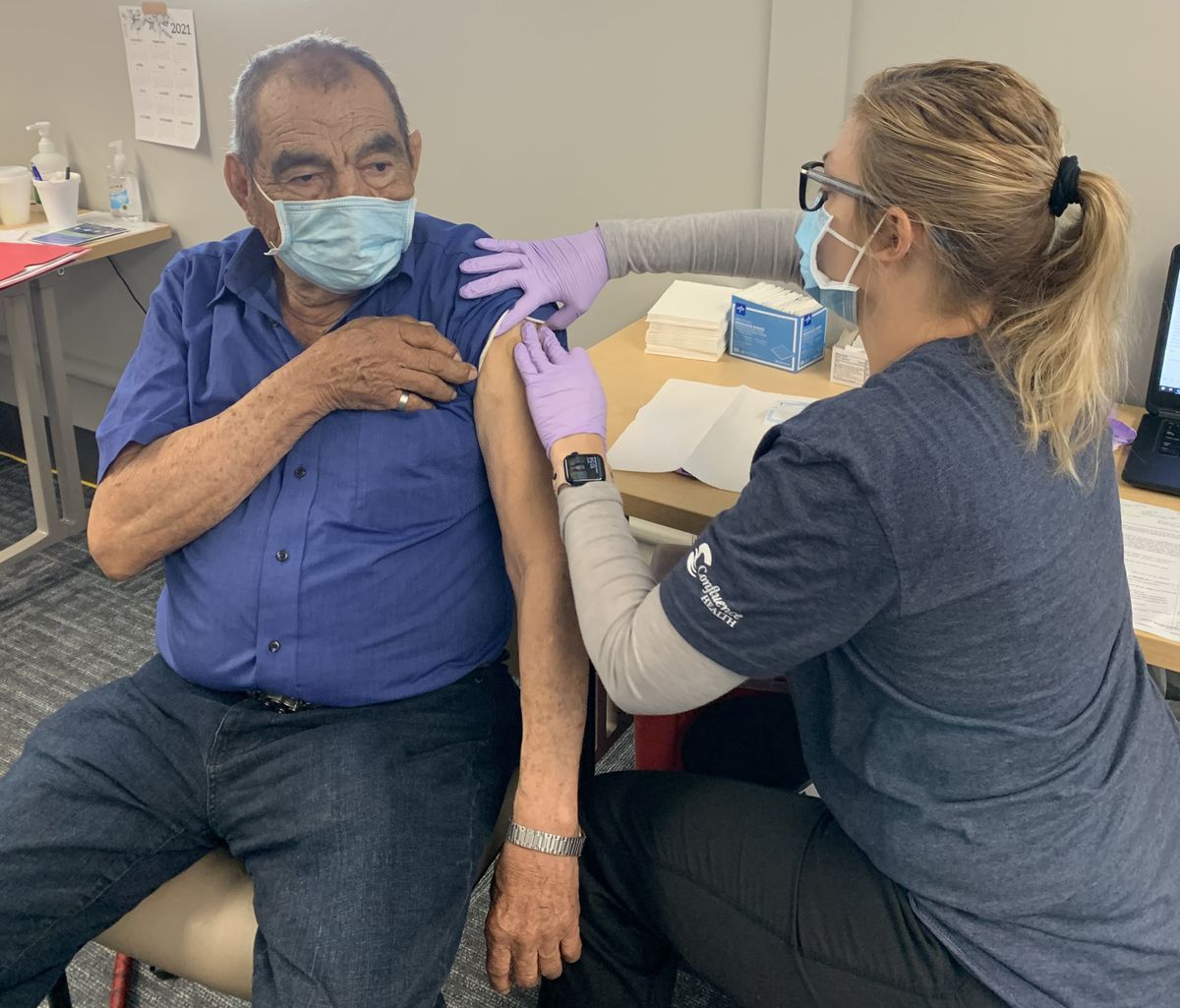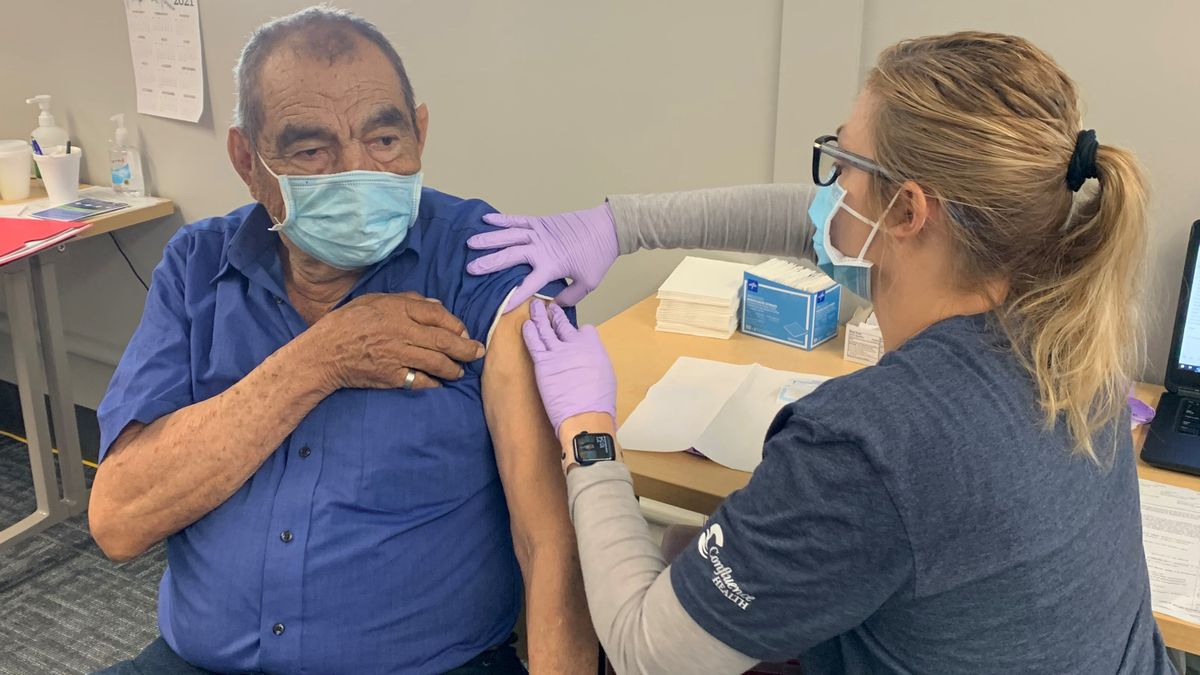‘They’re not an afterthought’: Advocates push to overcome Latino vaccine hesitancy
Vaccination rates among Latino people are lagging, prompting community organizations to help with clinics. (Courtesy of Teresa Bendito)
Like many other Latino organizers, Teresa Bendito anticipated the difficulties in making sure Latinos would have access to COVID-19 vaccines.
So when each group was approved to receive the vaccine, she made a list of all the businesses and organizations in Wenatchee and nearby towns so Parque Padrinos organizers could bring health resources directly to those who need them.
Bendito, who co-founded Parque Padrinos in November 2020, has worked to provide COVID-19 information to Spanish-speaking communities, undocumented people and community members who are often sidelined, she said.
“We have focused more of our efforts in person,” Bendito said. “We go and speak to the workers so it’s primarily on the ground and in-person, so they could really place a face to a name.”
Vaccination rates for Hispanic people remain low in comparison to how many Hispanic people fell ill with COVID-19, according to a Washington State Department of Health report.
A carefully tailored approachBefore Parque Padrinos became an official nonprofit earlier this year, advocates and members of the group had been helping people make appointments, debunking vaccine misinformation, connecting them with resources and pointing them to vaccine clinics, Bendito said.
“It means everything to be able to make sure people are not left behind and (their ability to get vaccinated) isn’t something that becomes secondary and that they’re not an afterthought,” she said.
The message resonates differently when it comes from members of their community, Bendito added.
“The people who are working in their own communities are recognized by their own neighbors and families,” she said. “So there’s already some level of trust that exists, which helps address vaccine hesitancy and is vital to successfully address the existing disparities.”
Bendito said organizers have set up information booths and vaccine clinics at fruit-packing warehouses, parks, and even yard sales.
“We go and meet them wherever they might be in order for us to not miss anybody,” she said.
Karina Vega-Villa, member of the Immigrant and Latinx Solidarity Group based out of the Wenatchee Valley, said members meet every week to discuss disparities in vaccine rates and find ways to bring community health care providers and community-based organizations together.
Parque Padrinos helped 876 people make appointments during March, Bendito said.
Efforts have spanned outside of Wenatchee and East Wenatchee to Orondo, Chelan, Rock Island and neighboring towns in Central Washington.
“We’re there three weeks later for their second appointment and provide transportation as well,” Bendito said. “Doing this provides some moral support and says, ‘I’m here with you in this and you’re not alone.’ ”
Having support from hospitals and state agencies has helped community organizers reach all the different sectors across the Latino community, Bendito said.
Addressing vaccine hesitancy and inaccessibility
Some people have expressed concerns about the presence of the National Guard at some vaccination sites, Bendito said. But vaccination rates have increased as people go through those vaccination sites and relay to other community members that it’s a safe space, she added.
People also are worried about the potential side effects and if they would cause them to miss work, Bendito said. Organizers have assured them that side effects will be minimal and, if severe, their employer should allow them to rest, she said.
Side effects are a sign that the body is building protections against the virus, according to the Centers for Disease and Control Prevention.
Common side effects when receiving the COVID-19 vaccine include pain, redness and arm swelling.
Other side effects can range from fatigue, headaches, muscle pains, chills and fevers, according to the CDC. Applying a cold washcloth over the arm that received the vaccine can help alleviate some of the pain, and drinking plenty of fluids can help with the other possible side effects, according to the CDC.
Sometimes people want to think the gaps in vaccination rates are because of hesitancy, but it also has to do with access, said Michele Roberts, acting assistant secretary of the state health department.
DOH has been working with community-based organizations across the state to address the lack of access and build vaccine confidence among Latinos, Roberts said. For these efforts to be successful, they must involve trusted Latino community members, she said.
There’s a lot of misinformation and conspiracy theories surrounding the vaccine, so it’s important to stress that the COVID-19 vaccines are safe and the most effective way to prevent COVID-19 related hospitalizations and deaths, Roberts said.
“They’re really what’s going to get us out of this pandemic,” she said.
Citizenship is not a requirement to receive the vaccine, Roberts said.
Vega-Villa said organizers and outreach coordinators noticed poverty and language differences were major reasons preventing Latino households and non-Latino households from getting vaccinated.
So the group provides Spanish-language education materials and many can be accessed through the DOH website.
“We need to do the work to ensure to our undocumented community that the hospital is a safe place to go and their information won’t be shared with any entity, and it’s only for demographic data,” Bendito said.
Vega-Villa said the limited access to DOH data on vaccinated people at the city and county levels has hindered efforts to identify where organizations need to alter their outreach so they can meet the needs of the different facets of the community and make sure vaccine distribution is equitable.
“It may take 45 minutes or it may take several days to understand why there is hesitancy,” she said. “This is taking a statewide effort from Latino community members to happen.”
Leaders need to know the demographics of people receiving the vaccination to create effective education plans that reach facets of the community who may be hesitant, she said.
Conversations were difficult in the beginning, Vega-Villa said, because there was a lot of pushback from local health officials about the expertise Latino community members bring.
“We see the need in our community and we want to respond, we want to help, and when the right partnerships happen, the whole community benefits,” she said.
Vital partnerships and quashing misinformationLindsey Peonio, human resources director for Douglas Fruit Inc., said the company undertook efforts to get workers vaccinated as soon as they became eligible.
The local health district did not have the resources to put on an onsite vaccine clinic for the 240 workers residing in the employer-provided housing, so the company offered transportation to mass vaccination sites, she said.
“From the beginning, we took the stance that we wanted to be a part of the solution to stop the spread of COVID-19 and provide the safest workplace possible,” she said. “They’re essential, and I don’t think people understand what it takes to get an apple from a tree to the store … we want to keep those workers safe.”
Many warehouse and orchard employees received the vaccine on their own as soon as they were eligible, Peonio said. Seeing co-workers receive the vaccine with minimal side effects increased the confidence in receiving it, she added.
Sharai Lopez, quality control employee at Douglas Fruit warehouse, said she knew she would receive the vaccine as soon as it was made more accessible to her through her employer.
“This is something that not only will protect me from contracting the virus but will also protect my coworkers and the people around me,” she said.
Lopez said some of her co-workers didn’t want to receive the vaccine because they were misinformed and thought they would die if they received it or didn’t understand what they would be injected with.
The COVID-19 vaccine aids the immune system in fighting against illnesses, infections and viruses such as COVID-19. The vaccine helps the body develop immunity to the COVID-19 virus without having to get the illness, according to the CDC.
The company was able to put on a vaccine on-site clinic last month and prioritized employees, then extended access to family members. Although the clinic was run on a limited basis, they were able to vaccinate about 375 people in one day, Peonio said.
Many farmworkers and agricultural workers are being vaccinated at clinics put on by their employers in collaboration with health care providers, Vega-Villa said.
“It’s important to have strong collaborations with employers, but one thing that needs to be done better is that these workers need to have accessible information about (different vaccine) options, because there’s still so much to do,” she said.

